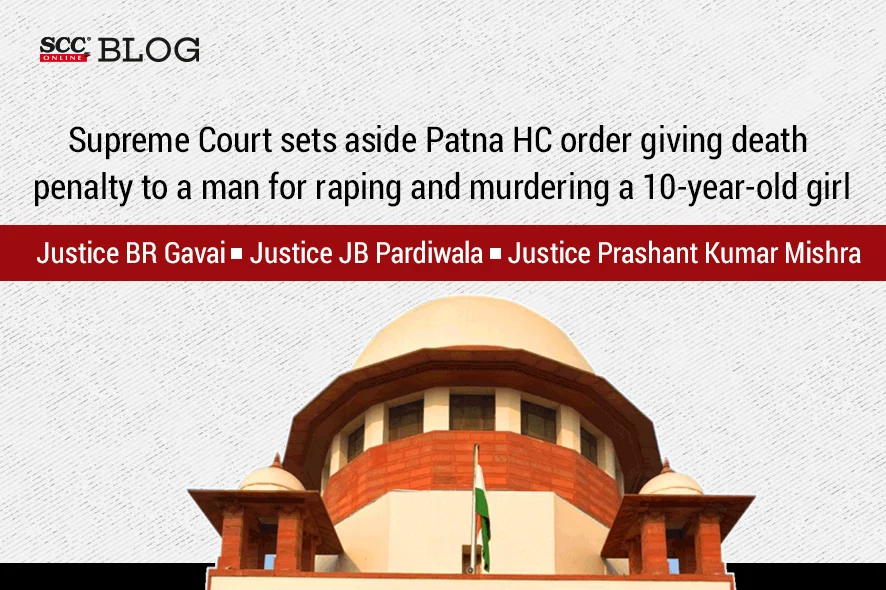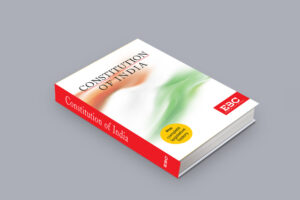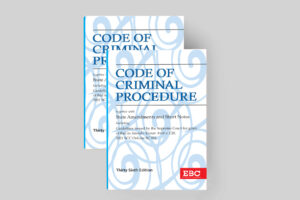Supreme Court: In an appeal by the convict against the judgment and order passed by the Patna High Court, wherein the Court sentenced him to death for the offence of rape and murder of a 10-year-old girl, the full bench of BR Gavai, JB Pardiwala*, and Prashant Kumar Mishra, JJ. has set aside the impugned judgment and remitted the matter to the High Court to decide the reference under Section 366 of the CrPC in the manner it ought to have been decided. Further, directed the High Court to take up this death reference for hearing expeditiously as the convict is in jail for past more than nine years.
Issue: Whether the High Court committed any error in passing the impugned judgment?
Analysis:
The Court said that the High Court proceeded on the footing that it was the convict who came to the house of the victim in the morning of 31-05-2015 and lured her to come to his house to watch TV. The High Court took the view that since the dead body of the victim was recovered from the room owned by the convict and he was seen by the victim’s sister locking the door attached to his house, it could be none other than the convict who could be said to have committed the crime. The High Court completely forgot that there was a co-accused in the picture, who being a juvenile was tried in accordance with the provisions of the Juvenile Justice Act, 2015 and was held guilty and sentenced to three years imprisonment.
Forensic Science Laboratory (FSL) Report not obtained
The Court said that there very serious lapses in the entire investigation, as the investigating officer in her cross examination before the Trial Court admitted that on the instructions of her senior officers, she did not take any steps to procure FSL report. The Court said that it should be a subject matter of inquiry by both the State as well as the Trial Court that who these senior officers were and why they instructed the investigating officer not to procure the FSL report.
Failure to Conduct Medical Examination
The Court pointed out another serious flaw in the present case on the part of the investigating officer, that is the failure to subject the convict to medical examination by a medical practitioner. No explanation has been offered for such a serious flaw on the part of the investigating officer.
The Court after taking note of Section 53(1) and Section 53-A of the Criminal Procedure Code, 1973 (‘CrPC’), and the ratio in Chotkau v. State of U.P., (2023) 6 SCC 742 , said that medical examination of an accused assumes great importance in cases where the victim of rape is dead, and the offence is sought to be established only by circumstantial evidence.
Further Statement under Section 313 CrPC
The Court was shocked to see the manner in which the Trial Court recorded the further statement of the convict under Section 313 CrPC. Four questions were put to the convict to enable him to explain the incriminating circumstances pointing towards his complicity in the alleged crime.
The Court noted that the case of all the witnesses before the police was that it was the co-accused who had come to the house of the victim on the fateful day and had taken the victim along with him to his house to watch TV. All the statements further reveal that it was the co-accused who was found locking the door when the witnesses enquired with him about the whereabouts of the victim. Thus, the Court said that neither the defense counsel nor the public prosecutor nor the presiding officer of the Trial Court and unfortunately even the High Court thought fit to look into the aforesaid aspect of the matter and try to reach to the truth.
The Court opined that the Trial Judge did not look at the record of the police investigation until after the investigating officer had been examined and discharged as a witness. Even at this stage, the Trial Judge could have recalled the officer and other witnesses and questioned them in the manner provided by Section 165 of the Evidence Act. It is regrettable that he did not do so.
After taking note of Section 162 CrPC , the Court said that the first part of Section 162 prohibits the use of the statement of a witness to a police officer for any purpose, other than that subsequently provided for in the proviso, and as the proviso says that the Court may permit the accused to contradict the witness with his previous statement, the Court has no power to do anything suo motu. This would be a misreading of the Section. The first part of Section 162 says that the statement made by a person to a police officer during investigation cannot be used for any purpose other than that mentioned in the proviso. However, the word ‘purpose’ mentioned in the proviso is for the purpose of contradicting the evidence given in favour of the State by a prosecution witness in Court using the previous statement made by such witness to the police officer. The purpose is to discredit the evidence given in favour of the prosecution by a witness for the State. The Section prohibits the use of the statement for any other purpose than this. It does not say that the statement can only be used at the request of the accused. The limitation or restriction imposed in the first part of Section 162 CrPC relates to this purpose for which the statement may be used; it does not relate to the procedure which may be adopted to affect this purpose.
Thus, the Court opined that nothing in Section 162 of the CrPC prevents a Trial Judge from looking into the papers of the chargesheet suo motu and for using the statement of a person examined by the police recorded therein for the purpose of contradicting such person when he gives evidence in favour of the State as a prosecution witness.
The Court further opined that in the present case where the evidence given in a Court implicates persons who are not mentioned in the first information report or police statements, it is always advisable and far more important for the Trial Judge to look into the police papers in order to ascertain whether the persons implicated by witnesses, at the trial had been implicated by them during the investigation.
The Court relied on V.K. Mishra v. State of Uttarakhand, (2015) 9 SCC 588 , and said that if the witness was not confronted with that part of the statement with which the defence wanted to contradict him, then the Court cannot suo motu make use of statements to police, not proved in compliance with Section 145 of the Evidence Act. Therefore, it is of utmost importance to prove all major contradictions in the form of material omissions in accordance with the procedure as established under Section 145 of the Evidence Act and bring them on record. It is the duty of the defence counsel to do so.
Role and duty of the High Court in confirmation cases
The Court took note of Sections 366, 367, 368 CrPC, and said that these provisions entitle the High Court to direct further enquiry or to take additional evidence and the High Court may, in a given case, even acquit the accused person. The scope of the chapter is wider.
Concept of fair trial
The Court said that free and fair trial is sine-qua-non of Article 21 of the Constitution of India. If the criminal trial is not free and fair, then the confidence of the public in the judicial fairness of a judge and the justice delivery system would be shaken. No trial can be treated as a fair trial unless there is an impartial judge conducting the trial, an honest, able and fair defence counsel and equally honest, able and fair public prosecutor. A fair trial necessarily includes fair and proper opportunity to the prosecutor to prove the guilt of the accused and opportunity to the accused to prove his innocence.
As per the Court if the Courts are to impart justice in a free, fair and effective manner, then the presiding judge cannot afford to remain a mute spectator, totally oblivious to the various happenings taking place around him. A fair trial is possible only when the court takes active interest and elicit all relevant information and material necessary to find out the truth for achieving the goal of dispensing justice with all fairness and impartiality to both the parties.
Thus, the Court set aside the impugned judgment of the High Court and remit the matter to the High Court for deciding the reference under Section 366 of the CrPC in the manner it ought to have been decided, due to the serious lapses on the part of the defence in not proving major contradictions in the form of material omissions surfacing from the oral evidence of the prosecution witnesses.
[Munna Pandey v. State of Bihar, 2023 SCC OnLine SC 1103, decided on 04-09-2023]
*Judgment Authored by: Justice J.B. Pardiwala
Know Thy Judge | Supreme Court of India: Justice J.B. Pardiwala








